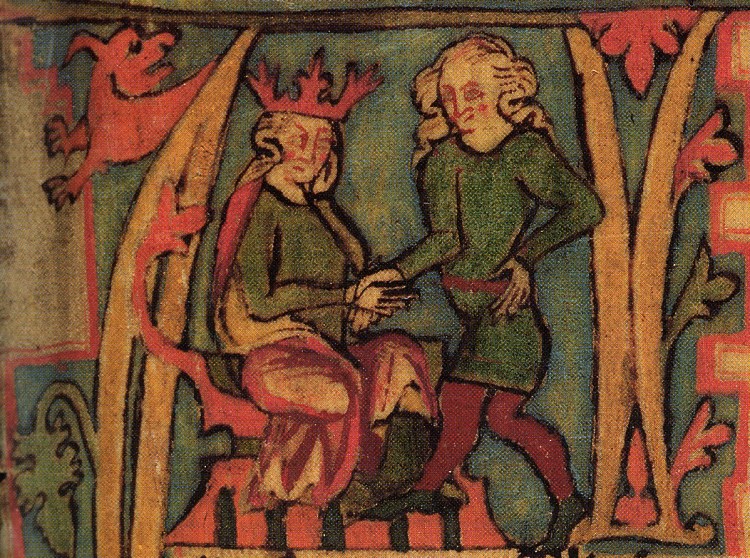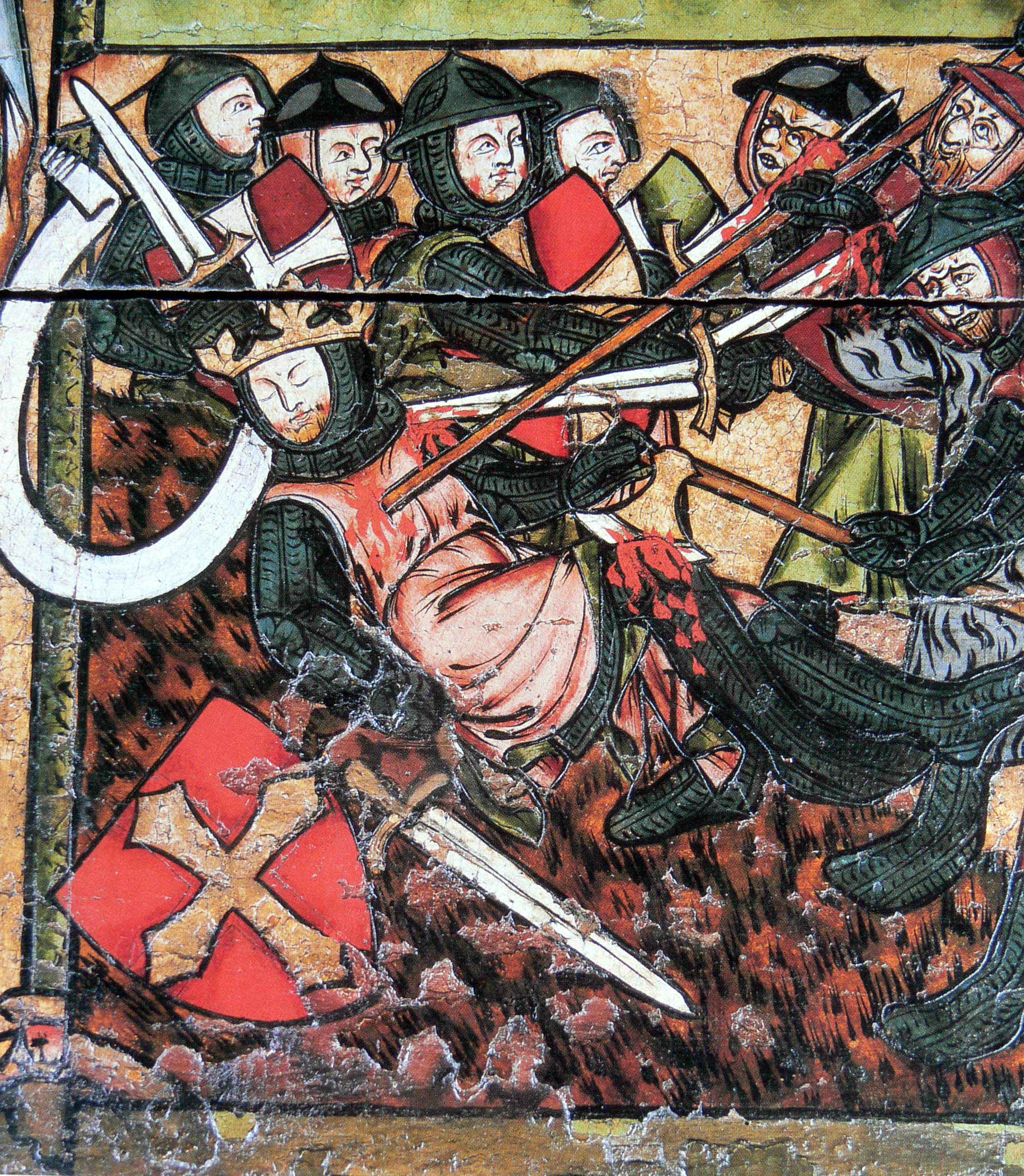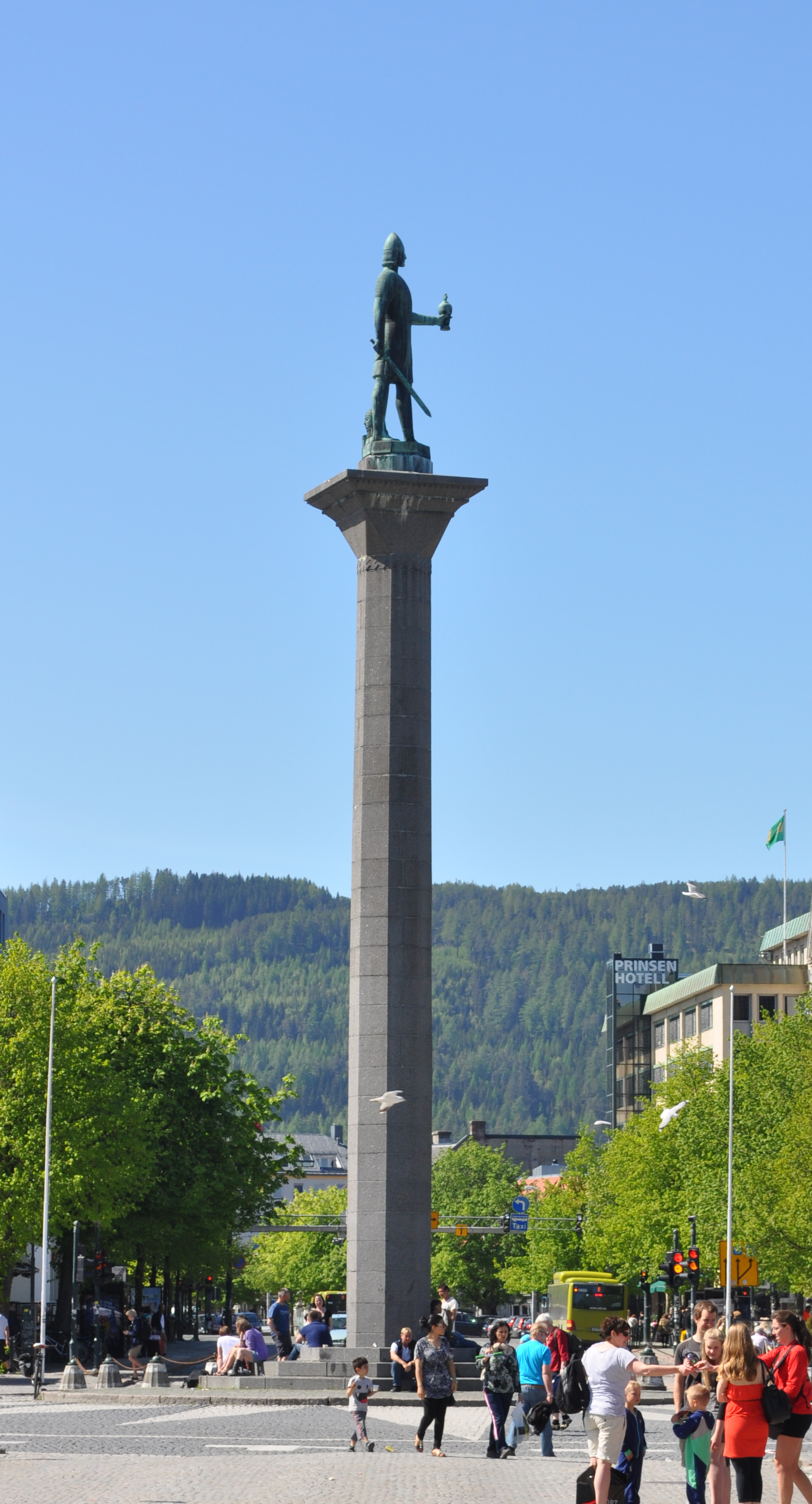|
Sweyn Knutsson
Svein Knutsson ( ; c. 1016–1035) was the son of Cnut the Great, king of Denmark, Norway, and England, and his first wife Ælfgifu of Northampton, a Mercian noblewoman. In 1017 Cnut married Emma of Normandy, but there is no evidence that Ælfgifu was repudiated, and in 1030 Cnut sent her and Svein as regents to rule Norway. However, their rule was considered oppressive by the Norwegians. They imposed new taxes and harsh laws that made them unpopular and they were expelled in 1034.Derry, T. K., A history of Scandinavia: Norway, Sweden, Denmark, Finland, and Iceland', University of Minnesota Press, 2000, p. 40. Names Svein Knutsson is also mentioned as Sveinn Alfífuson (matronym) and under the epithet ''óforsynjukonungr'' ("unforeseen king"). In Norwegian, his name is ''Svein Knutsson''; in Danish, ''Svend Knudsen''. Many variations of the name are used, including Sven and Sweyn, from the Anglo-Saxon Swegen. He was the second ruler of Norway by this name, after his grandfath ... [...More Info...] [...Related Items...] OR: [Wikipedia] [Google] [Baidu] |
List Of Norwegian Monarchs
The list of Norwegian monarchs ( or ''kongerekka'') begins in 872: the traditional dating of the Battle of Hafrsfjord, after which victorious King Harald Fairhair Unification of Norway, merged several Petty kingdoms of Norway, petty kingdoms into that of his father. Named after the Norway#Etymology, homonymous geographical region, Harald's realm was later to be known as the Norway, Kingdom of Norway. Traditionally established in 872 and existing continuously for over 1,100 years, the Kingdom of Norway is one of the oldest states of Europe: King Harald V of Norway, Harald V, who has reigned since 1991, is the 64th monarch according to the official list. During interregnum, interregna, Norway has been ruled by variously titled regents. Several royal Dynasty, dynasties have possessed the Throne of the Kingdom of Norway: the more prominent include the Fairhair dynasty (872–970), the House of Sverre (1184–1319), the House of Oldenburg (1450–1481, 1483–1533, 1537–1818, and f ... [...More Info...] [...Related Items...] OR: [Wikipedia] [Google] [Baidu] |
Battle Of Stiklestad
The Battle of Stiklestad (; ) in 1030 is one of the most famous battles in the history of Norway. In this battle, King Olaf II of Norway () was killed. During the pontificate of Pope Alexander III, the Roman Catholic Church declared Olaf a saint in 1164. His younger half-brother, Harald Hardrada (), was also present at the battle. Harald was only fifteen when the battle of Stiklestad took place. He became King of Norway in 1047, until his death in a failed invasion of England at the Battle of Stamford Bridge in 1066. Background During the 9th century, Norway was divided between several local kings controlling their own fiefs. By the end of the century, King Harald Fairhair (Old Norse: ) managed, mainly due to the military superiority gained by his marriage alliance with Hákon Grjótgarðsson of Nidaros, to subjugate these mini–kingdoms, and he created a unified Norwegian state. This alliance came apart after Harald's death. The jarls of Lade and various descendants of Haral ... [...More Info...] [...Related Items...] OR: [Wikipedia] [Google] [Baidu] |
Skagerrak
The Skagerrak (; , , ) is a strait running between the North Jutlandic Island of Denmark, the east coast of Norway and the west coast of Sweden, connecting the North Sea and the Kattegat sea. The Skagerrak contains some of the busiest shipping routes in the world, with vessels from every corner of the globe. It also supports an intensive fishing industry. The ecosystem is strained and negatively affected by direct human activities. Oslo and Gothenburg are the only large cities in the Skagerrak region. The strait is likely named after Skagen, a town near the northern cape of Denmark, with 'Rak' meaning 'straight waterway'. The Skagerrak is 240 km long and 80–140 km wide, deepening towards the Norwegian coast. It has an average salinity comparable to other coastal waters, housing a variety of habitats. Historically, the Skagerrak was the only access to the Baltic Sea until the construction of the Eider Canal in 1784. During both World Wars, the strait held strategic importance ... [...More Info...] [...Related Items...] OR: [Wikipedia] [Google] [Baidu] |
Agder
Agder is a counties of Norway, county () and districts of Norway, traditional region in the southern part of Norway and is coextensive with the Southern Norway region. The county was established on 1 January 2020, when the old Vest-Agder and Aust-Agder counties were merged. Since the early 1900s, the term Southern Norway, Sørlandet ("south country, south land, southland") has been commonly used for this region, sometimes with the inclusion of neighbouring Rogaland. Before that time, the area was considered a part of Western Norway. The area was a medieval Petty kingdoms of Norway, petty kingdom, and after Norway's unification became known as ''Egdafylki'' and later ''Agdesiden'', a county within the kingdom of Norway. The name Agder was not used after 1662, when the area was split into smaller governmental units called Nedenæs, Råbyggelaget, Lister, and Mandal. The name was resurrected in 1919 when two counties of Norway that roughly corresponded to the old Agdesiden county w ... [...More Info...] [...Related Items...] OR: [Wikipedia] [Google] [Baidu] |
Trondheim
Trondheim ( , , ; ), historically Kaupangen, Nidaros, and Trondhjem (), is a city and municipality in Trøndelag county, Norway. As of 2022, it had a population of 212,660. Trondheim is the third most populous municipality in Norway, and is the fourth largest urban area. Trondheim lies on the south shore of Trondheim Fjord at the mouth of the River Nidelva. Among the significant technology-oriented institutions headquartered in Trondheim are the Norwegian University of Science and Technology (NTNU), the Foundation for Scientific and Industrial Research (SINTEF), the Geological Survey of Norway (NGU), and St. Olavs University Hospital. The settlement was founded in 997 as a trading post and served as the capital of Norway from the Viking Age until 1217. From 1152 to 1537, the city was the seat of the Catholic Archdiocese of Nidaros; it then became, and has remained, the seat of the Lutheran Diocese of Nidaros and the site of the Nidaros Cathedral. It was incorporated ... [...More Info...] [...Related Items...] OR: [Wikipedia] [Google] [Baidu] |
Olav Tryggvason
Olaf Tryggvason (960s – 9 September 1000) was King of Norway from 995 to 1000. He was the son of Tryggvi Olafsson, king of Viken ( Vingulmark, and Rånrike), and, according to later sagas, the great-grandson of Harald Fairhair, first King of Norway. He is numbered as Olaf I. Olaf was important in the conversion of the Norse to Christianity, but he did so forcibly within his own kingdom. He is said to have built the first Christian church in Norway in 995, and to have founded the city of Trondheim in 997. A statue dedicated to him is located in the city's central plaza. Historical information on Olaf is sparse. He is mentioned in some contemporary English sources, and some skaldic poems. The oldest narrative source mentioning him briefly is Adam of Bremen's '' Gesta Hammaburgensis ecclesiae pontificum'' of ''circa'' 1070. In the 1190s, two Latin versions of ''" Óláfs saga Tryggvasonar"'' were written in Iceland, by Oddr Snorrason and Gunnlaugr Leifsson – these are ... [...More Info...] [...Related Items...] OR: [Wikipedia] [Google] [Baidu] |
Tryggve The Pretender
Tryggvi "the Pretender" (Old Norse ''Tryggvi Ólafsson'', Norwegian ''Tryggve Olavsson'') was a Viking chieftain who lived in the early eleventh century, and came from "west across the sea" (probably from the Norse settlements in England and Ireland). His story appears in ''Heimskringla'' by Snorri Sturluson, the saga ''Morkinskinna'', and a saga composed by Oddr Snorrason on Olaf Tryggvason. Invasion of Norway According to ''Heimskringla'', in 1033, during the lordship of Cnut the Great's son Svein over Norway, Tryggvi invaded Norway. He claimed to be the son of Olaf Tryggvason and his wife Gyda.Hollander (2002:534). His enemies scoffed at this claim, asserting that Tryggvi was instead the bastard son of a priest; however, Snorri Sturluson refers to Olaf's relatives in Viken as Tryggvi's "kinsmen;" moreover, the author of ''Morkinskinna'' has Harald Hardrada asserting kinship with the then-deceased Tryggvi, indicating that at least some people believed Tryggvi's claim. When ... [...More Info...] [...Related Items...] OR: [Wikipedia] [Google] [Baidu] |
Ryfylke
Ryfylke is a Districts of Norway, traditional district in the northeastern part of Rogaland county, Norway. The district, encompassing about 60% of the county's area is located northeast of Stavanger and east of Haugesund. It includes the mainland, which is northeast and east of the Boknafjorden and east of the Høgsfjorden. It also consists of the islands on the south side of the Boknafjorden. To the east, Ryfylke borders the districts of Setesdal and Sirdal, to the south is Jæren, and to the west is Haugalandet. Ryfylke is one of the 15 districts in Western Norway. Ryfylke comprises the contemporary municipalities of Sauda, Suldal, Hjelmeland, Strand, Norway, Strand, Kvitsøy, the eastern island portion of Stavanger, the Forsand part of Sandnes, and eastern Gjesdal. There are no large cities in Ryfylke, but there are two large towns, Sauda (town), Sauda and Jørpeland. Scenic attractions include the Lysefjord with the mountains of Preikestolen ("Pulpit Rock") and Kjerag. Th ... [...More Info...] [...Related Items...] OR: [Wikipedia] [Google] [Baidu] |
Battle Of Soknasund
A battle is an occurrence of combat in warfare between opposing military units of any number or size. A war usually consists of multiple battles. In general, a battle is a military engagement that is well defined in duration, area, and force commitment. An engagement with only limited commitment between the forces and without decisive results is sometimes called a skirmish. The word "battle" can also be used infrequently to refer to an entire operational campaign, although this usage greatly diverges from its conventional or customary meaning. Generally, the word "battle" is used for such campaigns if referring to a protracted combat encounter in which either one or both of the combatants had the same methods, resources, and strategic objectives throughout the encounter. Some prominent examples of this would be the Battle of the Atlantic, Battle of Britain, and the Battle of France, all in World War II. Wars and military campaigns are guided by military strategy, whereas batt ... [...More Info...] [...Related Items...] OR: [Wikipedia] [Google] [Baidu] |
Heimskringla
() is the best known of the Old Norse kings' sagas. It was written in Old Norse in Iceland. While authorship of ''Heimskringla'' is nowhere attributed, some scholars assume it is written by the Icelandic poet and historian Snorri Sturluson (1178/79–1241) 1230. The title was first used in the 17th century, derived from the first two words of one of the manuscripts (''kringla heimsins'', "the circle of the world"). is a collection of sagas about Swedish and Norwegian kings, beginning with the saga of the legendary Swedish dynasty of the Ynglings, followed by accounts of historical Norwegian rulers from Harald Fairhair of the 9th century up to the death of the pretender Eystein Meyla in 1177. Some of the exact sources of ''Heimskringla'' are disputed, but they include earlier kings' sagas, such as Morkinskinna, Fagrskinna and the 12th-century Norwegian synoptic histories and oral traditions, notably many skaldic poems. The author or authors explicitly name the now lost w ... [...More Info...] [...Related Items...] OR: [Wikipedia] [Google] [Baidu] |
Snorri Sturlasson
Snorri Sturluson ( ; ; 1179 – 22 September 1241) was an Icelandic historian, poet, and politician. He was elected twice as lawspeaker of the Icelandic parliament, the Althing. He is commonly thought to have authored or compiled portions of the ''Prose Edda'', which is a major source for what is today known about Norse mythology and alliterative verse, and , a history of the Norse kings that begins with legendary material in ''Ynglinga saga'' and moves through to early medieval Scandinavian history. For stylistic and methodological reasons, Snorri is often taken to be the author of ''Egil's Saga''. He was assassinated in 1241 by men claiming to be agents of the King of Norway. Biography Early life Snorri Sturluson was born in (commonly transliterated as Hvamm or Hvammr) as a member of the wealthy and powerful Sturlungar clan of the Icelandic Commonwealth, in AD 1179. His parents were Sturla Þórðarson the Elder of Hvammur (also known as Hvamm-Sturla) and his second wi ... [...More Info...] [...Related Items...] OR: [Wikipedia] [Google] [Baidu] |





